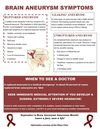MidTerm Flashcards
Taken from the study guide Prof Laird handed us. (50 cards)
Airborne Precautions - MTV
M - measles
T - TB
V - varicella (private room)
Body Mechanics Guidelines
- Plan ahead
- Position yourself close to the load
- Test the load before lifting!
- Maintain a wide BoS
- Maintain normal spine curvature whenever possible
- Bend the hips and knees
- Exhale during exertion
- Avoid twisting at the trunk, particularly when the trunk is flexed
- Push rather than pull when possible
- Get help if needed!
How often should we change a dependent patient’s position?
Every 2 hours
Symptoms of Aneurysm

Max A
Maximum Assistance - Patient doing 25% of the work, PT doing 75%
Should be in front of patient for Max A
Nervous System Division

What is thermanalgesia?
Loss of the temperature sense or of the ability to distinguish between heat and cold; insensibility to heat or to temperature changes.
Long-Term Positioning Checklist
- Clear airway
- Good spinal alignment
- Minimize pressure over bony prominences
- Minimize gravity creating shearing forces
- Cushioned support surfaces to minimize pressure
- Immobile extremities elevated
- Positioned to prevent joint and soft tissue contractures
- Support and stability provided for trunk extremities
- Positioned to allow patient maximum long-term function
- Positioned to optimize interaction with the environment
- Special needs accommodated
Mod A
Moderate Assistance - Patient doing 50% of the work, PT doing 50%
Contact Precautions - Mrs. Wee
M - multidrug resistant organism
R - respiratory infection
S - skin infections
W - wound infections
E - enteric (c. diff)
E - eye infection - conjunctivitis
Brachial Pulse
In the antebrachial fossa, just medial to the biceps brachii tendon
<1 year: Upper extremity musculature is not sufficiently developed to interfere with brachial artery palpation. During emergencies, direct auscultation is a faster and more accurate method than palpation.
Signs and Symptoms of Myocardial Infarction

Airborne Precautions
- Chickenpox
- Disseminated herpes zoster (shingles)
- Measles
N-95 Mask:
- Tuberculosis
- SARS
- Avian influenza
DT Grading
4+ Very brisk
3+ Brisker than average
2+ Average, normal
1+ Diminished, low normal
0 No response
If lateral assessment shows forward head and rounded shoulders, what would you expect on posterior assessment?

Portals of Entry
- Penetration: a foreign body allowing bacteria entry into internal body cavities. eg. Medical: Catheterization, surgical drains, or Trauma: wooden sliver or metal spike breaks the skin
- Direct contact: transmission via touch, person-person (person with contaminated hands touching another person) or person-contaminated contact surface (doorknob, tap etc.)
- Ingestion: consumption of contaminated, toxin-laden foods (Salmonella), poisonous plants or chemicals
- Inhalation: air-borne contaminants are inhaled into the lungs and respiratory tract. pathogens such as fungal spores or microbes, toxins, aerosol droplets of contaminated bodily fluids (sputum from a cough).
Host Reservoir
The reservoir of an infectious agent is the habitat in which the agent normally lives, grows, and multiplies. Reservoirs include humans, animals, and the environment.
Orthostatic Hypotension
- AKA Postural hypotension
- Occurs when there is a decrease in BP of at least 20 mmHg systolic and 10 mmHg diastolic within 3 min of standing up (or from supine to sit)
- Failure of the systolic pressure to increase with increasing workload
- All should result in immediate cessation of activity!!
-
Can be associated with:
- Cardiac abnormalities
- Decreases in cardiac blood volume (venous pooling)
- Use of certain pharmacological drugs (ie. HTN drugs)
- Central, peripheral, autonomic nervous system disorders (TBI, DM, SCI)
Pressure Ulcers - Predisposing Factors
- Inability to move independently
- History of skin breakdown
- Bladder and/or bowel incontinence
- Absent or impaired sensation
- Fragile or friable skin
- Impaired circulation
- Cachexia - a condition of severe weight loss including muscle wasting
- Muscle atrophy
- Postural impairments
- Nutritional deficits
- Impaired cognitive ability
- Medication use that affects mobility or awareness
- Friction and shear (consider when moving/transferring patients! - avoid bed elevation > 30º)
Calculate Max HR and Percentage for target HR during exercise
- Maximal HR: the maximum recommended physiological intensity for a given individual during exercise
- Estimated Maximum HR = 220 - the person’s age
- Target HR: specific range of HR intensity to achieve aerobic training effect
- Target HR = Maximum HR * Desired intensity (%)
Dorsalis Pedis Pulse

Carotid Pulse
Place the fingers just to the side of the larynx (Adam’s apple) and medial to the SCM
Where would a patient receive a nosocomial infection?
From the hospital
Detrimental Effects of Bedrest
- Loss of muscle mass
- Poor respiratory function
- Poor cardiac function - orthostatic hypotension
- Pressure ulcers
- Poor swallowing function - aspiration









